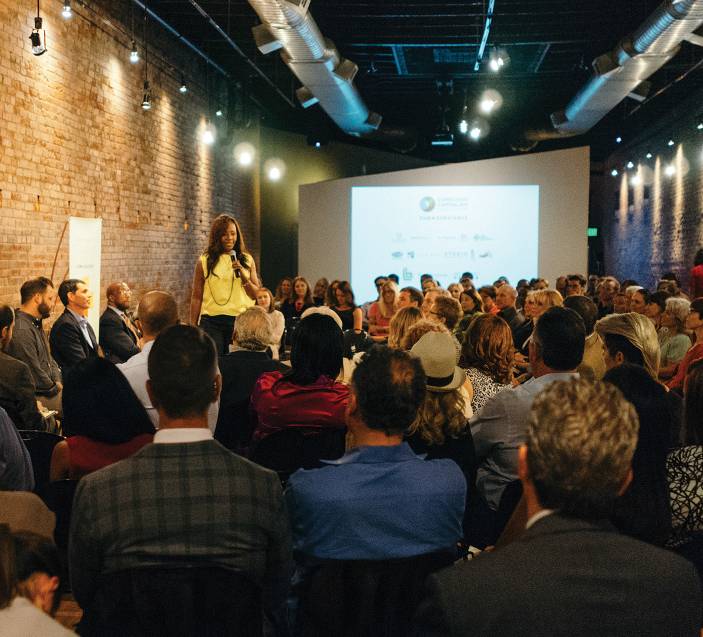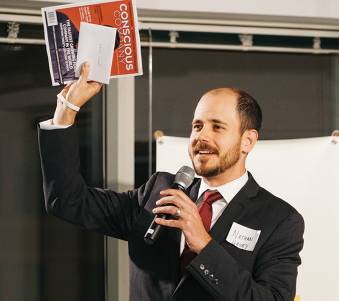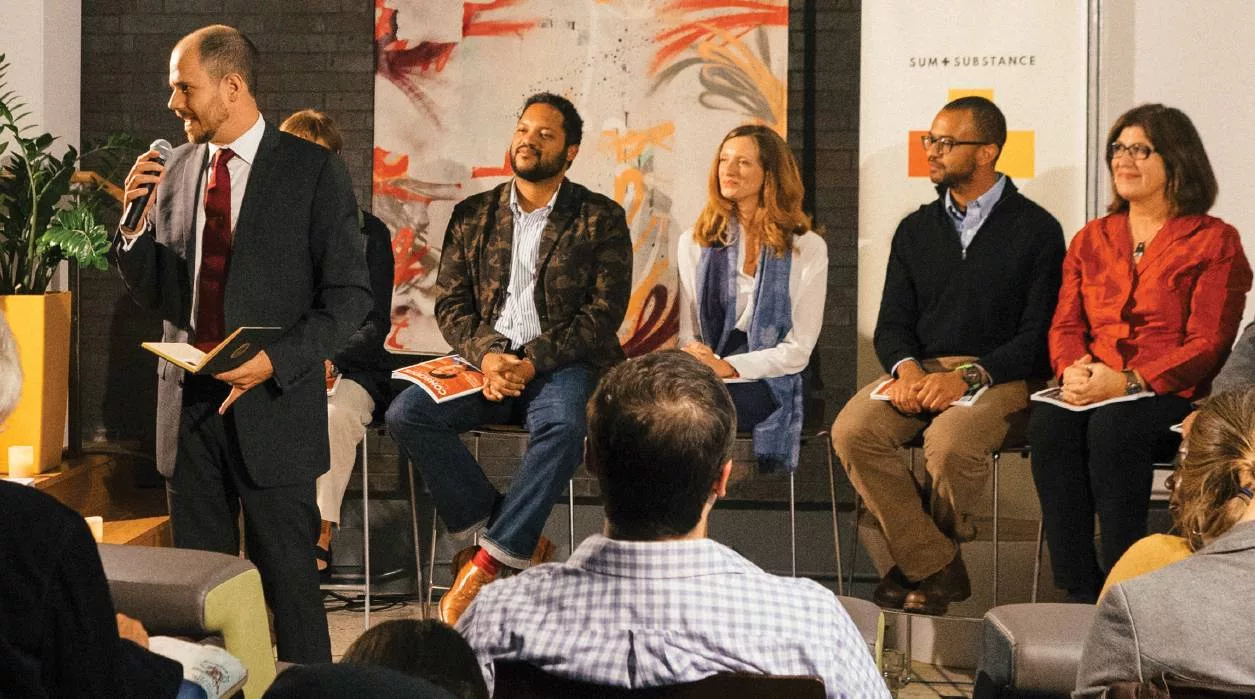“Chronic illness accounts for 75 percent of US healthcare costs. The single greatest contributor to chronic illness is chronic stress, and the leading source of stress is work — especially work that is dehumanizing, unenjoyable, and meaningless.”
In March of 2015, 140 people gathered at Impact Hub Boulder in Colorado to celebrate the launch of CONSCIOUS COMPANY. As part of the celebration, five Colorado businesspeople told their stories of how they found fulfillment in their professions. They also challenged the people in the crowd to do something that would advance their personal fulfillment through work.
By all accounts it was a great event. But in the days that followed, we discovered that for some attendees it had been more than that. Taking the challenges to heart, some people had quit their jobs, some had met with supervisors to tackle issues that had been simmering for years, and some had (finally) started the company of their dreams. We set out to launch a magazine that night, but we ended up launching a national conversation as well.
According to Gallup’s State of the American Workplace study, 70 percent of people are disengaged from their jobs. That means they come to work and do what they are supposed to do, but they don’t have much heart in it. They look forward to the end of the day and the end of the week. Maybe it is due to a bad boss, maybe it is work they don’t particularly enjoy, maybe it is an absence of deeper meaning, but whatever the cause, these people — most of us — don’t care that much. Within that 70 percent, a little less than 20 percent of people, one in five, are actively disengaged. That means they are actively sabotaging the success of their employers.
Gallup estimates that this status quo, which it says is holding back the economy, costs the US between $450 and $550 billion in lost productivity each year. The social costs, however, are harder to measure. Chronic illness accounts for 75 percent of US healthcare costs. The single greatest contributor to chronic illness is chronic stress, and the leading source of stress is work — especially work that is dehumanizing, unenjoyable, and meaningless.
We spend half of our waking adult lives at work. The influence that workplace culture has on us, our families, and our communities is difficult to overstate. In our companies and in our lives, we must balance our financial ability to sum with our human capacity for substance.
A little more than five months after experiencing the power of that storytelling event in Boulder, we kicked off the inaugural national tour of an event series about fulfillment at work. We called it Sum and Substance.
Sum and Substance held events in five cities last year: Seattle, Raleigh, Dallas, Boston, and Chicago. In sum, 28 storytellers challenged more than 400 people to take the next step on their own journeys to fulfillment at work; the stories are available for your viewing pleasure at www.sumandsub.com. In substance, a national conversation was started to urge people not to settle, and to help employers focus on the purpose beyond profit that businesses exist to fulfill.
Through survey responses submitted by Sum and Substance attendees the day after the show, along with other writings on the topic, we are studying workplace fulfillment more deeply. We don’t have any grand conclusions to share just yet, but we do have a few interesting anecdotes.
We asked people to tell us what fulfillment at work meant to them, and we got a wide variety of responses. Among those responses there were five words that were used more frequently than any others:
POSITIVE
DIFFERENCE
PEOPLE
WORLD
IMPACT

Gail Warrior tells her story at Sum+Substance Dallas
We also asked attendees how fulfilled they are at their jobs now, and what, if anything, about their current job was not fulfilling. The average fulfillment score was a seven out of ten (more on that in a future article), but several people reported being unfulfilled, clocking in at five or below. Here is what that sounds like:
• “I don’t believe the work that I’m doing is helping others.”
• “I believe in the mission … but I don’t feel valued or challenged.”
• “I don’t feel like I have a purpose within the organization.”
• “I don’t have any agency to run projects I care about.”
Finally, we wanted to know whether Sum and Substance had changed the way attendees thought about fulfillment at work. The results on this question were mixed. Some people, particularly those who said they are currently fulfilled at work, reported no change. But others reported a significant change. One woman who attended the event in Dallas had this to say:
“I used to think that fulfillment at work was something that few people were lucky enough to experience. Hearing five stories at one time and knowing that this event has been done in several cities somehow makes fulfillment at work seem more attainable.”
In 2016, Sum and Substance will bring events to more cities, and as we do, we’ll share what we are learning in the pages of this magazine. In the meantime, go forth and do good work.

Nathan Havey and his team at Thrive Consulting Group partnered with Conscious Company Magazine to create Sum+Substance. He hosted the 2015 tour and is proud to serve on the advisory board of Conscious Company Magazine.
DO MANAGERS HAVE A RESPONSIBILITY TO HELP PEOPLE FEEL FULFILLED?
According to legendary systems thinker Peter Senge, “To be effective today, the leader shoulders an almost sacred responsibility to create conditions that enable people to have happy and productive lives.” So that’s a “yes,” but how should a manager do that, exactly?
Much of the research we’ve seen points to a nearly universal desire among employees to feel cared about on a personal, not just professional, level. In his wonderful book “Lead from the Heart,” leadership consultant and speaker Mark Crowley offers managers a five-step process for making a personal connection and thereby inspiring employees to reach their highest achievements and fulfillment. The key is periodic one-on-one meetings.
1: CLARIFY YOUR INTENTIONS
When you set up the meeting, make sure you tell your employee that you want to talk about their career and personal development aspirations. Ask them to spend some time before the meeting thinking about how you could help them grow professionally.
2: EXPRESS GRATITUDE
One-on-one meetings with the boss carry an anxiety-producing stigma. Open the meeting by expressing sincere gratitude for all of the work the employee has done. Be specific. This will help the employee relax and set the tone you want.
3: FOCUS ON THE EMPLOYEE
Address any questions or concerns the employee brings to the meeting, and schedule more time if you can’t get them resolved right away. Identify what motivates your employee and what is important to them. Identify short- and long-term career aspirations and establish a development plan. Finally, use the final moments of the meeting to solicit suggestions for how you can improve as a leader.
4: DISCOVER DREAMS AND ASPIRATIONS
Ask the employee how they feel about the progress they are making toward their goals and whether there are specific skills they would like to develop. Ask if they have given thought to next steps and long-term destinations. Find out what you can do to help them achieve their dreams.
5: DEVELOP A PLAN
A written plan that gets filed in a drawer and forgotten about is no good here. You need to demonstrate a real commitment to helping your employee grow by following through on your end of the plan that you create together.







